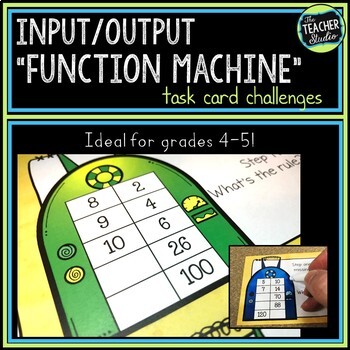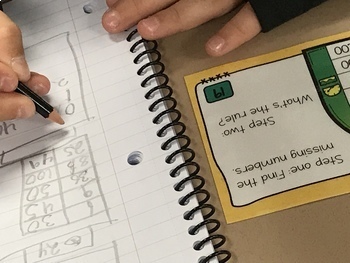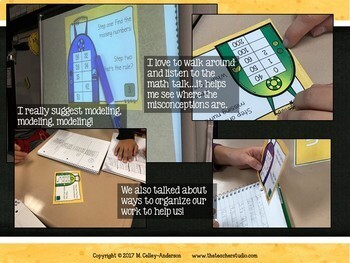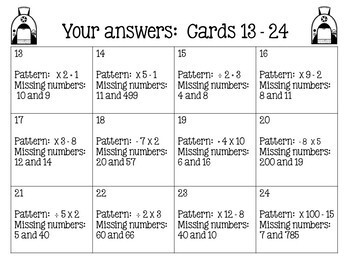Input - Output Machine Math Challenge Task Cards - Function Machine Problems
- PDF
- Google Apps™

What educators are saying
Description
This set of 24 input/output table task card math challenges are perfect to use as whole class warm-ups, small group instruction, math stations or centers, or even as intervention groups to work on problem solving and algebra thinking. Students love the function machines and the level of challenge varies for easy differentiaton.
Although designed to be used with fourth and fifth graders, these cards would also be perfect to use with older students needing additional review with algebra thinking. NOW INCLUDES DIGITAL SLIDE ACCESS!
The 24 problems included require students to use different operations (addition, subtraction, multiplication, and division) to solve a variety of input/output problems.
Students may be able to see the mathematical pattern (ex. “This is a
times 3, then subtract 4 pattern.”) or may end up using guess and check strategies to solve the problems. Students are not expected to use algebraic reasoning—but I DID pull some of my top students to show them how to write these “expressions” with variables. They LOVED it!
What do you get?
- Answers are included as are three rubrics to use to help in scoring the Standards for Mathematical Practice!
- Cards are included in both color and low-ink, black and white versions for ultimate flexibility.
- There are blank recording sheets that can be used for students to track their work, or they can simply do their work in a notebook.
- Answer key!
WHY DID I CREATE THESE?
Over the years I have noticed that students are often in search of an easy answer…a “fill in the blank”. The simple fact is, math is sometimes more complicated than that! In this set of task cards I want students to struggle…something many have never had to do!
In these input/output problems, students need to recognize that when you put a number in (left side of chart), “something” happens in the machine and a new number comes out. It could be something simple—like the machine could add 3 or double the number—or it could be more complex—like the machine multiplies the number times 3 and then takes away 1.
These more complex operations are not immediately obvious and require students to do some real algebraic thinking, guessing and checking, and reasoning.
When I first started, I heard lots of “I don’t get it!” and “It’s impossible!”, so I projected a card on the screen and talked through my guess and check strategies. Full color photos are even included with some teaching ideas!
WHAT IS THE CHALLENGE LEVEL?
Cards 1 - 12
These cards involve one step—for example, “add 12” or “double”. They are great to get started…and may be enough for some students! We did the first four as a class, and then students worked in partners to try the others.
Cards 13 – 24
These last 12 cards have TWO steps…making the pattern FAR more challenging to find. Cards may have patterns such as “multiply by 9, then subtract 2” or “multiply by 3 and then add 8”. All four operations are included. These are NOT easy! Students may get frustrated but encourage them to persevere, work together, and use their brains! These would also be perfect for an enrichment group or a station for fast finishers.
----------------------------------------------------------------------------------
Interested in a set of other algebra challenges?
This resource is also available as part of a "Teaching Tandem" product where you can get this resource AND a set of algebra thinking concept sorts combined at a reduced price. CLICK HERE TO VIEW
This is also available as a digital task card resource in my GOOGLE EDITION resources! CLICK HERE TO VIEW
-----------------------------------------------------------------------------------
All rights reserved by ©The Teacher Studio. Purchase of this resource entitles the purchaser the right to reproduce the pages in limited quantities for single classroom use only. Duplication for an entire school, an entire school system, or commercial purposes is strictly forbidden without written permission from the author at fourthgradestudio@gmail.com. Additional licenses are available at a reduced price.





